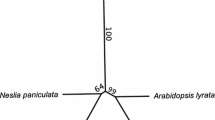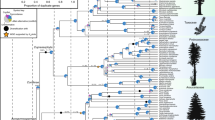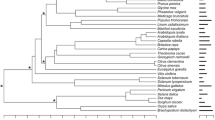Abstract
The evolutionary rate at which DNA sequences evolve is known to differ between different groups of organisms. However, the reasons for these different rates are seldom known. Among plants, the generation-time hypothesis, which states that organisms that reproduce faster also have more DNA substitutions per time, has gained most popularity. We evaluate the generation-time hypothesis using 131 DNA sequences from the plastid trnLF region and the nuclear ribosomal ITS region of the genus Veronica (Plantaginaceae). We also examine the alternative hypothesis that a higher substitution rate is correlated with selfing breeding system. Selfing is associated with annual life history in many organisms and may thus often be the underlying reason for observed correlations of annual life history with other characters. We provide evidence that annual life history is more likely to be the responsible factor for higher substitution rates in Veronica than a selfing breeding system. Nevertheless, the way in which annual life history may influence substitution rate in detail remains unknown, and some possibilities are discussed.




Similar content being viewed by others
References
Aarssen LW (2000) Why are most selfers annuals? A new hypothesis for the fitness benefit of selfing. Oikos 89:606–612
Ainouche AK, Bayer RJ (1999) Phylogenetic relationships in Lupinus (Fabaceae: Papilionoideae) based on internal transcribed spacer sequences (ITS) of nuclear ribosomal DNA. Am J Bot 86:590–607
Albach DC (2006) Evolution of Veronica on the Balkan Peninsula. Phytol Balcanica 12:231–244
Albach DC, Chase MW (2001) Paraphyly of Veronica (Veroniceae; Scrophulariaceae): evidence from the internal transcribed spacer (ITS) sequences of nuclear ribosomal DNA. J Plant Res 114:9–18
Albach DC, Chase MW (2004) Incongruence in Veroniceae (Plantaginaceae): evidence from two plastid and a nuclear ribosomal DNA region. Mol Phylog Evol 32:183–197
Albach DC, Greilhuber J (2004) Genome size variation and evolution in Veronica. Ann Bot 94:897–911
Albach DC, Meudt HM (2009) Phylogeny of Veronica in the Southern and Northern Hemispheres based on plastid, nuclear ribosomal and nuclear low-copy DNA. Mol Phylog Evol
Albach DC, Martínez-Ortega MM, Chase MW (2004a) Veronica: parallel morphological evolution and phylogeography in the Mediterranean. Plant Syst Evol 246:177–194
Albach DC, Martínez-Ortega MM, Fischer MA, Chase MW (2004b) Evolution of Veroniceae: a phylogenetic perspective. Ann Mo Bot Gard 91:275–302
Albach DC, Utteridge T, Wagstaff SJ (2005) Origin of Veroniceae (Plantaginaceae, formerly Scrophulariaceae) on New Guinea. Syst Bot 30:410–421
Andreasen K, Baldwin BG (2001) Unequal evolutionary rates between annual and perennial lineages of checker mallows (Sidalcea, Malvaceae): evidence from 18S–26S rDNA internal and external transcribed spacers. Mol Biol Evol 18:936–944
Archibald JK, Mort ME, Crawford DJ, Kelly JK (2005) Life history affects the evolution of reproductive isolation among species of Coreopsis (Asteraceae). Evolution 59:2362–2369
Aris-Brosou S (2007) Dating phylogenies with hybrid molecular clocks. PLoS ONE 2:e879
Barraclough TG, Savolainen V (1996) Rate of rbcL gene sequence evolution and species diversification in flowering plants (angiosperms). Proc R Soc Lond B 263:589–591
Barraclough TG, Savolainen V (2001) Evolutionary rates and species diversity in flowering plants. Evolution 55:677–683
Bennett MD (1972) Nuclear DNA content and minimum generation time in herbaceous plants. Proc R Soc Lond B 181:109–135
Bousquet J, Strauss SH, Doerksen AH, Price RA (1992) Extensive variation in evolutionary rate of rbcL gene sequences among seed plants. Proc Natl Acad Sci USA 89:7844–7848
Britten RJ (1986) Rates of DNA sequence evolution differ between taxonomic groups. Science 231:1393–1398
DePamphilis CW, Young ND, Wolfe AD (1997) Evolution of plastid gene rps2 in a lineage of hemiparasitic and holoparasitic plants: Many losses of photosynthesis and complex patterns or rate variation. Proc Natl Acad Sci USA 94:7367–7372
Doyle JJ, Doyle JL (1987) A rapid DNA isolation procedure for small quantities of fresh leaf tissue. Phytochem Bull Bot Soc Am 19:11–15
Duminil J, Grivet D, Ollier S, Jeandroz S, Petit RJ (2008) Multilevel control of organelle DNA sequence length in plants. J Mol Evol 66:405–415
Eyre-Walker A, Gaut BS (1997) Correlated rates of synonymous site evolution across plant genomes. Mol Biol Evol 14:455–460
Fitch WM, Beintema JJ (1990) Correcting parsimonious trees for unseen nucleotide substitutions: the effect of dense branching as exemplified by ribonuclease. Mol Biol Evol 7:438–443
Gaut BS, Muse SV, Clark WD, Clegg MT (1992) Relative rates of nucleotide substitution at the rbcL locus of monocotyledonous plants. J Mol Evol 35:292–303
Gaut BS, Morton BR, McCaig BC, Clegg MT (1996) Substitution rate comparisons between grasses and palms: Synonymous rate differences at the nuclear gene Adh parallel rate differences at the plastid gene rbcL. Proc Natl Acad Sci USA 93:10274–10279
Gehrig HH, Aranda J, Cushman MA, Virgo A, Cushman JC, Hammel BE, Winter K (2003) Cladogram of Panamanian Clusia based on nuclear DNA: implications for the origins of Crassulacean acid metabolism. Plant Biol 5:59–70
Glémin S (2007) Mating systems and the efficacy of selection at the molecular level. Genetics 177:906–916
Glémin S, Bazin E, Charlesworth D (2006) Impact of mating systems on patterns of sequence polymorphism in flowering plants. Philos Trans R Soc Lond B Biol Sci 273:3011–3019
Hamrick JL, Godt MJW (1990) Allozyme diversity in plant species. In: Brown AHD, Clegg MT, Kahler AL, Weir BS (eds) Plan population genetics, breeding and genetic resources. Sinauer Associates, Sunderland, pp 43–63
Hamrick JL, Godt MJW (1996) Effects of life history traits on genetic diversity in plant species. Philos Trans R Soc Lond B Biol Sci 351:1291–1298
Holsinger KE, Feldman MW (1983) Modifiers of mutation rate: evolutionary optimum with complete selfing. Proc Natl Acad Sci USA 80:6732–6734
Hugall AF, Lee MSY (2007) The likelihood node density effect and consequences for evolutionary studies of molecular rates. Evolution 61:2293–2307
Kalisz S, McPeek MA (1992) The demography of an age-structured annual: resampled projection matrices, elasticity analysis and seed bank effects. Ecology 73:1082–1094
Kelchner SA (2002) Group II introns as phylogenetic tools: structure, function, and evolutionary constraints. Am J Bot 89:1651–1669
Kimura M (1968) Evolutionary rate at the molecular level. Nature 217:624–626
Kirik A, Salomon S, Puchta H (2000) Species-specific double-strand break repair and genome evolution in plants. EMBO J 19:5562–5566
Klekowski EJ (1989) Ageing and mutation in plants. Nature 340:389
Kolf M (2008) Pollen/Eizellen-Verhältnisse in Veronica—Phylogenetische Analyse und Beeinflussung durch differenziertes Ressourcenangebot innerhalb von Veronica persica. State examination thesis, Johannes Gutenberg-Universität Mainz
Kosakovsky Pond SL, Frost SDW, Muse SV (2005) HYPHY: hypothesis testing using phylogenies. Bioinformatics 21:676–679
Lanfear R, Thomas JA, Welch JJ, Brey T, Bromham L (2007) Metabolic rate does not calibrate the molecular clock. Proc Natl Acad Sci USA 104:15388–15393
Laroche J, Bousquet J (1999) Evolution of the mitochondrial rps3 intron in perennial and annual angiosperms and homology to nad5 intron 1. Mol Biol Evol 16:441–452
Martin AP, Palumbi SR (1993) Body size, metabolic rate, generation time, and the molecular clock. Proc Natl Acad Sci USA 90:4087–4091
Metzgar D, Wills C (2000) Evidence for the adaptive evolution of mutation rates. Cell 101:581–584
Morgan MT, Schoen DJ, Bataillon TM (1997) The evolution of self-fertilization in perennials. Am Nat 150:618–638
Morgan-Richards M, Wolff K (1999) Genetic structure and differentiation of Plantago major reveals a pair of sympatric sister species. Mol Ecol 8:1027–1036
Morrison DA (2007) Increasing the efficiency of searches for the maximum likelihood tree in a phylogenetic analysis of up to 150 nucleotide sequences. Syst Biol 56:988–1010
Müller K (2004) PRAP—computation of Bremer support for large data sets. Mol Phylogenet Evol 31:780–782
Müller K (2005) The efficiency of different search strategies in estimating parsimony jackknife, bootstrap, and Bremer support. BMC Evol Biol 5:58
Müller J, Müller K (2003) QuickAlign: a new alignment editor. Plant Mol Biol Rep 21:5
Müller J, Müller K (2004) TreeGraph: automated drawing of complex tree figures using an extensible tree description format. Mol Ecol Notes 4:786–788
Müller K, Borsch T, Legendre L (2006) Highly accelerated substitutional rates in the carnivorous Lentibulariaceae. Mol Phylogenet Evol 41:99–117
Nickrent DL, Duff RJ, Colwell AE, Wolfe AD, Young ND, Steiner KE, de Pamphilis CW (1998) Molecular phylogenetic and evolutionary studies of parasitic plants. In: Soltis DE, Soltis PS, Doyle JJ (eds) Molecular systematics of plants II. Kluwer, Boston, Dordrecht, London, pp 211–241
Nixon KC (1999) The parsimony ratchet, a new method for rapid parsimony analysis. Cladistics 15:407–414
Ohta T, Kimura M (1971) On the constancy of the evolutionary rate of cistrons. J Mol Evol 1:18–25
Page RDM, Holmes EC (1998) Molecular evolution: a phylogenetic approach. Blackwell Science, Oxford
Pannell JR, Barrett SCH (1998) Baker’s law revisited: reproductive reassurance in a metapopulation. Evolution 52:657–668
Posada D (2008) jModelTest: phylogenetic model averaging. Mol Biol Evol 25:1253–1256
Ronquist F, Huelsenbeck JP (2003) MrBayes 3: Bayesian phylogenetic inference under mixed models. Bioinformatics 19:1572–1574
Schoen DJ (2005) Deleterious mutations in related species of the plant genus Amsinckia with contrasting mating systems. Evolution 59:2370–2377
Silvertown J, Charlesworth D (2001) Introduction to plant population biology. Blackwell Science, Oxford
Smith SA (2008) Rates of molecular evolution are linked to life history in flowering plants. Science 322:86
Sniegowski PD, Gerrish PJ, Johnson T, Shaver A (2000) The evolution of mutation rates: separating causes from consequences. BioEssays 22:1057–1066
Stamatakis A, Ludwig T, Meier H (2005) RAxML-III: a fast program for maximum likelihood based inference of large phylogenetic trees. Bioinformatics 21:456–463
Stebbins GL (1957) Self fertilization and population variability in higher plants. Am Nat 91:337–354
Sun Y, Skinner DZ, Liang GH, Hulbert SH (1994) Phylogenetic analysis of Sorghum and related taxa using internal transcribed spacers of nuclear ribosomal DNA. Theor Appl Genet 89:26–32
Swofford DL (2002) PAUP* Phylogenetic analysis using parsimony (*and other methods), version 4. Sinauer Associates, Sunderland
Taberlet P, Gielly L, Pautou G, Bouvet J (1991) Universal primers for amplification of three non-coding regions of chloroplast DNA. Plant Mol Biol 17:1105–1109
Torrell M, Vallès J (2001) Genome size in 21 Artemisia L. species (Asteraceae, Anthemideae): Systematic, evolutionary, and ecological implications. Genome 44:231–238
Tsantes C, Steiper ME (2009) Age at first reproduction explains rate variation in the strepsirrhine molecular clock. Proc Natl Acad Sci USA 106:18165–18170
White TJ, Bruns T, Lee S, Taylor J (1991) Amplification and direct sequencing of fungal ribosomal RNA genes for phylogenetics. In: Innis M, Gelfand D, Sninsky J, White T (eds) PCR protocols: a guide to methods and applications. Academic Press, San Diego, pp 315–322
Whittle CA, Johnston MO (2002) Male-driven evolution of mitochondrial and chloroplastidial DNA sequences in plants. Mol Biol Evol 19:938–949
Whittle CA, Johnston MO (2003) Broad-scale analysis contradicts the theory that generation time affects molecular evolutionary rates in plants. J Mol Evol 56:223–233
Wu CI, Li WH (1985) Evidence for higher rates of nucleotide substitution in rodents than in man. Proc Natl Acad Sci USA 82:1741–1745
Xu HL, Swoboda I, Bhalla PL, Sijbers AM, Zhao CX, Ong EK, Hoeijmakers JHJ, Singh MB (1998) Plant homologue of human excision gene ERCC1 points to conservation of DNA repair mechanisms. Plant J 13:823–829
Zuckerkandl E, Pauling L (1965) Evolutionary divergence and convergence in proteins. Academic Press, New York
Zwickl D (2006) GARLI, Genetic Algorithm for Rapid Likelihood Inference, version 0.942
Acknowledgments
This research was funded by the Fonds zur Förderung wissenschaftlicher Forschung (FWF Austria) project P15336. KM thanks the Deutsche Telekom Stiftung for financial support 3 years ago when initial ideas and analyses for this study emerged. Some of the tests herein have been designed in the context of research funded by DFG Grant MU 2875/2-1 to KM. We thank Mark Chase for comments on an earlier version of the manuscript and two anonymous reviewers for helpful remarks.
Author information
Authors and Affiliations
Corresponding author
Electronic supplementary material
Below is the link to the electronic supplementary material.
Rights and permissions
About this article
Cite this article
Müller, K., Albach, D.C. Evolutionary Rates in Veronica L. (Plantaginaceae): Disentangling the Influence of Life History and Breeding System. J Mol Evol 70, 44–56 (2010). https://doi.org/10.1007/s00239-009-9307-5
Received:
Accepted:
Published:
Issue Date:
DOI: https://doi.org/10.1007/s00239-009-9307-5




